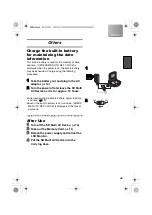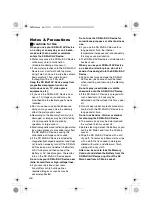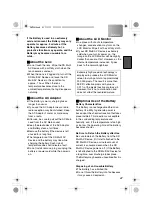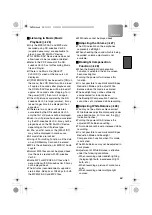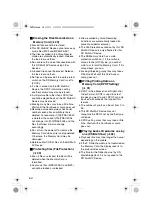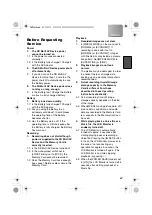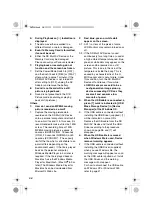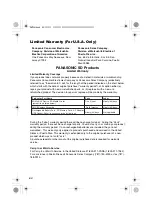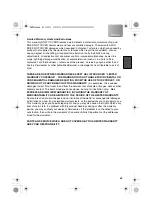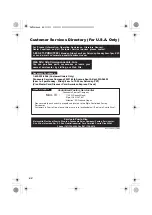
53
ª
Listening to Music (Music
Playback) (
l
26)
≥
Only the MPEG2-AAC and MP3 data
recorded using SD-Jukebox Ver.3.0
(supplied accessory) are applicable to
play on your SD Multi AV Device.
≥
This SD Multi AV Device alone does not
allow tracks to be recorded or deleted.
≥
Refer to the PDF manual of the SD-
Jukebox Ver.3.0 as for Recording Music
file and Playlist.
≥
If there is no Music file, [SELECT
PLAYLIST] screen on the menu is not
displayed.
≥
If [POWER SAVE] has been set to [ON] on
the menu, the LCD Monitor will be turned
off approx. 5 seconds after playback and
the SD Multi AV Device will be turned off
approx. 30 seconds after stopping. Turn
the power [OFF], then turn it on again.
≥
If the still picture associated by the SD-
Jukebox Ver.3.0 is large (volume), it may
take a longer time to be displayed than
expected.
≥
If there are two or more still pictures
associated by the SD-Jukebox Ver.3.0,
only the first still picture will be displayed.
≥
Even if a still picture has been associated
by the SD-Jukebox Ver.3.0, it may not be
played back on the SD Multi AV Device,
depending on the still picture type.
≥
A title, an artist name or the [PLAYLIST]
may not be displayed in some cases.
≥
All music files are locked.
≥
Using its Formatting Function, all the data
on an SD Memory Card can be erased.
≥
MP3 is the abbreviation for MPEG1 Audio
Layer3.
≥
Normal MP3 files cannot be played back.
Use the data created with SD-Jukebox
Ver.3.0.
≥
Some MP3 or MPEG2-AAC files which
were written with SD-Jukebox Ver.3.0 may
not be played back.
≥
The bit rates (recommended) supported
are 64 kbps, 96 kpbs or 128 kbps for both
the MPEG2-AAC and MP3 files.
≥
WMA data cannot be played back.
ª
Adjusting the Volume (
l
27)
≥
The L/R indication on the earphones
represents Left/Right.
≥
When checking the sound which is being
recorded, volume adjustment is not
available.
ª
Backlight Compensation
Function (
l
28)
≥
When the Backlight Compensation
Function is activated, the entire screen
becomes brighter.
≥
Turning the power off will release this
function.
≥
It is not possible to use Horizontal Stripes
Reduction Mode and to adjust White
Balance when this mode is activated.
≥
The backlight may not be sufficiently
compensated for in dark places.
≥
The Backlight Compensation Function
cannot be set or released while recording.
ª
Adjusting White Balance (
l
28)
≥
You may not be able to achieve correct
White Balance adjustment manually under
weak illumination. (In this case, the [
1
]
Indication flashes.)
≥
Turning the power off will release the
adjusted White Balance setting.
≥
This mode cannot be set or released while
recording.
≥
It is not possible to use Horizontal Stripes
Reduction Mode and Backlight
Compensation Function when this mode
is activated.
≥
The White Balance may not be adjusted in
dark places.
≥
Adjustment of White Balance is effective
under the following conditions.
-
When recording under reddish lighting
(halogen light bulb, incandescent light
bulb, etc.).
-
When recording a picture of mono-tone
color.
-
When recording under multiple light
sources.
AV20U.book 53 ページ 2003年4月2日 水曜日 午後9時9分





